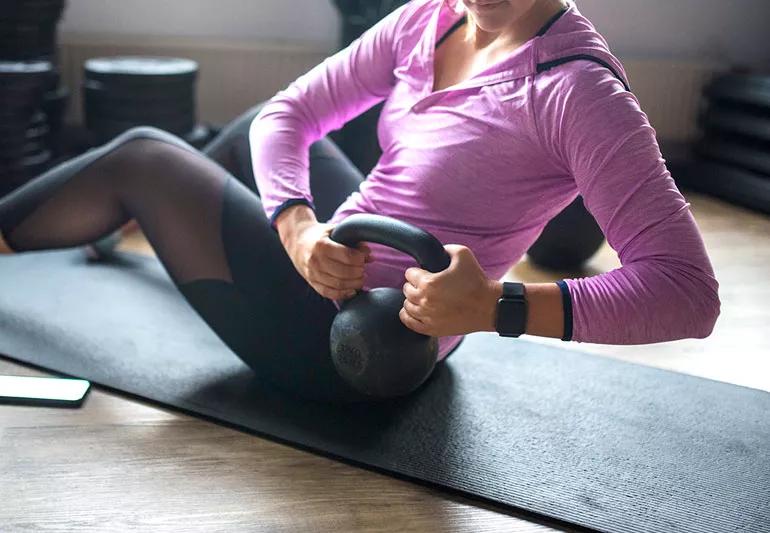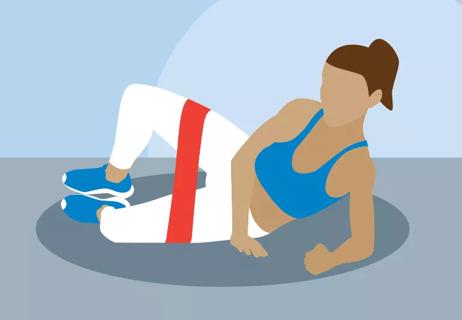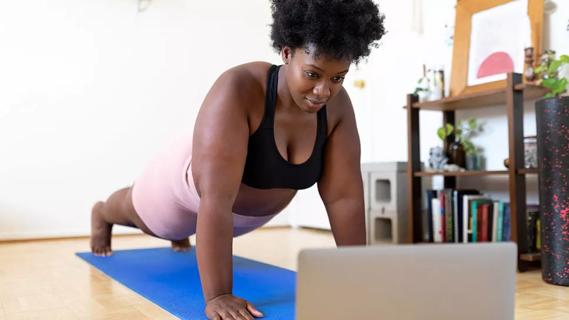Kettlebells can amp up your workout game

Kettlebells aren’t new. These cannonball-looking weights with handles have been around since at least the 1700s. Some people believe they were used in ancient Greece. And kettlebell training became quite popular in Russia and Germany during the 18th and 19th centuries.
Advertisement
Cleveland Clinic is a non-profit academic medical center. Advertising on our site helps support our mission. We do not endorse non-Cleveland Clinic products or services. Policy
Kettlebells are usually made out of cast iron or steel, but you can also find options filled with sand or water. And they can weigh from five pounds to well over 200 pounds.
They’re a staple in many home gyms. That’s because they’re perfect for small workout spaces and versatile enough to use in a range of exercises that tone and strengthen your whole body.
But can anyone do kettlebell training, and should you attempt to use them without guidance from a trainer? We asked physical therapist Tyler Hewett, DPT, for advice about using kettlebells as part of your workout routine.
Kettlebells can be used to amp up just about any strengthening exercise, and training with a kettlebell can offer a number of benefits.
According to Dr. Hewett, “Kettlebells give people more variety in their workouts and offer different variations of body mechanics that allow muscle groups that haven’t been previously targeted to be isolated and challenged.”
The International Sports Sciences Association says kettlebell exercises can engage the entire body through multi-joint, functional movements. For example, a kettlebell swing engages your core, glutes, quads, hamstrings and back. Kettlebell training movements not only engage your entire body, but also challenge your balance and strength overall.
Advertisement
There is a huge variety of movements you can do with kettlebells, ranging from swinging them to upper body movements, squat variations and so much more. You can break a kettlebell workout down into basic movements such as shoulder presses, lunges, deadlifts and more. Once you feel more comfortable, you can add in dynamic, rigorous exercises such as swings and squat thrusts. Start slowly and work your way up.
Kettlebells can be used to add resistance to some of your go-to exercises for your glutes, lower back, hamstrings and quads.
You can also incorporate kettlebells into your upper-body workout to strengthen your arms, shoulders, chest and more.
Get even more benefit from your kettlebell training with advanced moves that work your whole body. You can also work more muscle groups by doing the exercises above, but with the kettlebell farther from your midline to add some additional difficulty as you work against gravity even more. For example, hold the kettlebell above your head while doing squats or lunges (being extra careful not to drop it on your head, of course!).
Advertisement
Safety is key to any kind of exercise program. Kettlebells are no exception.
Dr. Hewett recommends having a safe non-slip surface such as a yoga mat for any sort of dynamic movement during training.
If you work out regularly, Dr. Hewett also says that trying a basic kettlebell workout at home shouldn’t be a problem. If you’re new to all of it, Dr. Hewett suggests considering getting guidance from a certified trainer.
Advertisement
“If you are used to working out and are aware of proper mechanics, I recommend starting at home with lighter kettlebells. If you’re new to working out, it’s definitely a good idea to seek the advice of a certified trainer to prevent injury, as well as get an established idea of what is a good challenge for you.”
If you’re working out at home and want to incorporate kettlebell training into your routine, Dr. Hewett doesn’t recommend just grabbing a kettlebell and swinging away. Practice your movements slowly and without weight to establish proper mechanics.
Once you feel comfortable, gradually add weight.
Dr. Hewett says a common — and dangerous — mistake some people make when starting their training is choosing the wrong size kettlebells.
“It’s common that some people will enter a workout with one kettlebell and think it is a one-size-fits-all type of deal. That’s not the case,” Dr. Hewett stresses.
Start with kettlebells that are at a lighter weight (but not at a level where the exercises are super easy) and work your way up to a heavier weight that you can tolerate.
Kettlebells can be used in many different ways, so you’ll want a variety of weights based on the movements you plan for your workout. Using a too-heavy kettlebell weight can cause you to overcompensate, which can lead to injuries.
Advertisement
“You want to be careful not to jump into kettlebell training with too much weight,” Dr. Hewett cautions. “Too much too soon is a recipe for an injury.”
Dr. Hewett suggests strength training two to three times a week. And to make the most of your workout, be sure that you’re not isolating particular muscle groups. You’ll want to do compound exercises or movements that involve multiple muscle groups. To get results, you’ll need to keep it up.
“As long as it is done properly — and when I say ‘done properly,’ I emphasize using the right kettlebell weights and mechanics — kettlebell training is safe for most people to try,” says Dr. Hewett. “Listen to your body and adjust your training if you have any pain. And make sure you follow any general precautions needed if for any health conditions you have.”
Foundational strength is important before jumping into a kettlebell routine, Dr. Hewett adds. That means you’ll want to make sure you can safely and relatively easily do the basic exercises (such as a lunge, squat, etc.) with the proper form and without pain before adding any weight to the equation.
He also says that people with osteoporosis might be able to try kettlebell workouts with certain modifications added to prevent fractures. Kettlebells can also be safe for some people with arthritis in their back or knees, as long as they have the proper form and mechanics.
And remember: Exercising shouldn’t hurt. Pain is your body’s way of telling you to knock it off. To avoid injury, it’s important to listen to that. As with other strengthening workouts, work to the point of “feeling it” but never to the point of pain.
You should also avoid working out with kettlebells to the point of exhaustion. Lifting heavy things with too-tired arms is a good way to cause serious injury from exertion (not to mention broken toes from dropping heavy weights).
If you’re not sure if you should try kettlebell training or if you have questions about how to incorporate them into your routine, talk with a medical professional or certified trainer for advice.
Learn more about our editorial process.
Advertisement

Completing as many reps as possible can benefit your mind and body

Exercises to stretch your way to better strength

Find out which workout takes high-intensity training to another level

Losing belly fat can reduce your risk for chronic health conditions — try focusing on a diet high in lean protein, exercising regularly, reducing stress and getting quality ZZZs

It’s best to exercise before or after your fast, instead of during it

Absolutely! In fact, in many ways, exercise is key to recovery

The exercise — which you’ve probably been doing since grade school — can be intimidating, but proper form can help

Cardio is great for improving cognition, but strength and balance training are just as important

Type 2 diabetes isn’t inevitable with these dietary changes

Applying a hot or cold compress can help with pain